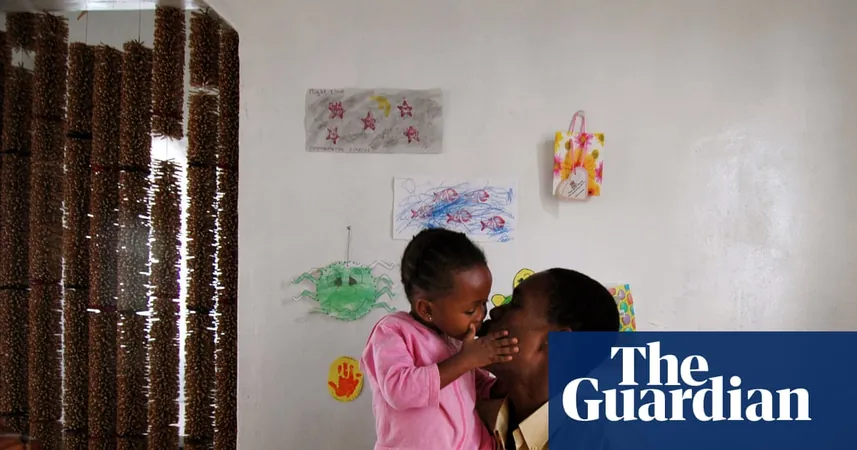
From Crisis to Triumph: Botswana's Unbelievable Victory Over HIV in Children
2025-08-22
Author: Jacob
A Nation on the Brink of Extinction
In the early 2000s, Botswana faced an unimaginable crisis as HIV ran rampant, putting the nation at risk of extinction. With one in eight infants born infected and a staggering mother-to-child transmission rate of 20 to 40%, the future looked bleak. In the heart of the struggle, then-President Festus Mogae sounded the alarm: "We are threatened with extinction." Dr. Loeto Mazhani, a pediatrician who witnessed this turmoil, remarked, "If your entire population is infected, you could see there was no future."
The Dawn of a New Era in Health Care
Against all odds, Botswana emerged as a global leader in the fight against HIV, especially in children. Spearheaded by Dr. Mazhani and backed by Mogae, innovative health interventions transformed the country's healthcare landscape. Over two decades, Botswana slashed mother-to-child transmission rates to below 1%. As recently as this year, the country was honored as the first high-burden nation to earn the World Health Organization's Gold Tier status for eliminating vertical HIV transmission as a public health threat.
A Hard-Won Transformation
The transformation was so dramatic that the WHO initially rejected the reported figures. Dr. Ava Avalos, an HIV specialist in Botswana, recalled, "They would say, 'No, you have 10,000 children that are HIV positive.'" Over time, they had to accept the reality of Botswana's groundbreaking success. Today, fewer than 100 HIV-positive infants are born each year, prompting rigorous audits of each case.
Overcoming Stigma and Sparking Change
Achieving this success took political will, scientific investment, and public health education. One of the greatest challenges was convincing HIV-positive mothers to use formula instead of breastfeeding—a cultural shift that initially caused stigma. Dr. Mazhani noted, "If a woman started using formula, everyone in the community would know she had HIV." But through education and outreach, this stigma gradually receded.
Innovative Strategies Yield Results
The implementation of the WHO’s Option B+ strategy in 2013 marked a pivotal moment. This initiative provided free antiretroviral therapy to all pregnant and breastfeeding women living with HIV—making Botswana one of the first countries globally to fund this on a national scale. Professor Roger Shapiro, who has been involved in HIV research in Botswana since the 1990s, stated, "It became clear that three-drug therapy was by far the best way to both treat mothers and eliminate vertical transmission."
Investing in Prevention and Testing
Recognizing that some transmissions still occurred during pregnancy, Botswana's health ministry invested in laboratories for extensive HIV testing. By offering repeat tests to all pregnant women, HIV-positive mothers could quickly receive treatment, significantly reducing the risk of passing the virus to their babies. With near-universal antenatal care, Botswana's healthcare system has ensured almost every child born to an HIV-positive mother is tested and treated early.
The Road Ahead: Trials and Tribulations
Botswana now boasts a special group of children whose virus levels are nearly undetectable, thanks to antiretroviral medications administered from birth. Recent conferences are exploring the possibility of these children being cured, with groundbreaking trials underway to test new therapies. With the economic landscape shifting due to foreign aid cuts and fluctuations in the diamond industry, Botswana's future public health investments become ever more precarious.
Hope on the Horizon
However, Botswana's existing infrastructure and a population of children who might achieve a cure give hope for future breakthroughs. As Avalos asserts, "If we can’t manage it here, I don’t know where we could do it." While challenges remain, the spirit of resilience in Botswana shines through—a true testament to the nation's journey from despair to hope in the battle against HIV.









 Brasil (PT)
Brasil (PT)
 Canada (EN)
Canada (EN)
 Chile (ES)
Chile (ES)
 Česko (CS)
Česko (CS)
 대한민국 (KO)
대한민국 (KO)
 España (ES)
España (ES)
 France (FR)
France (FR)
 Hong Kong (EN)
Hong Kong (EN)
 Italia (IT)
Italia (IT)
 日本 (JA)
日本 (JA)
 Magyarország (HU)
Magyarország (HU)
 Norge (NO)
Norge (NO)
 Polska (PL)
Polska (PL)
 Schweiz (DE)
Schweiz (DE)
 Singapore (EN)
Singapore (EN)
 Sverige (SV)
Sverige (SV)
 Suomi (FI)
Suomi (FI)
 Türkiye (TR)
Türkiye (TR)
 الإمارات العربية المتحدة (AR)
الإمارات العربية المتحدة (AR)